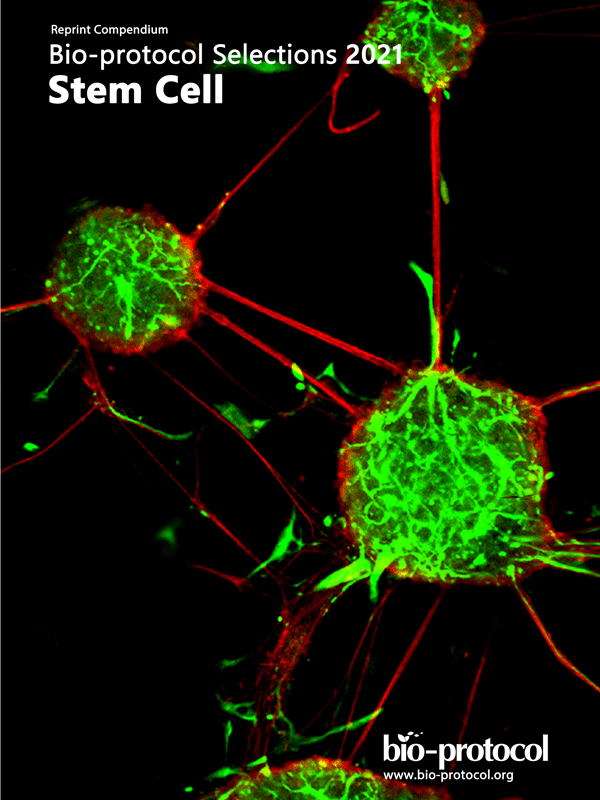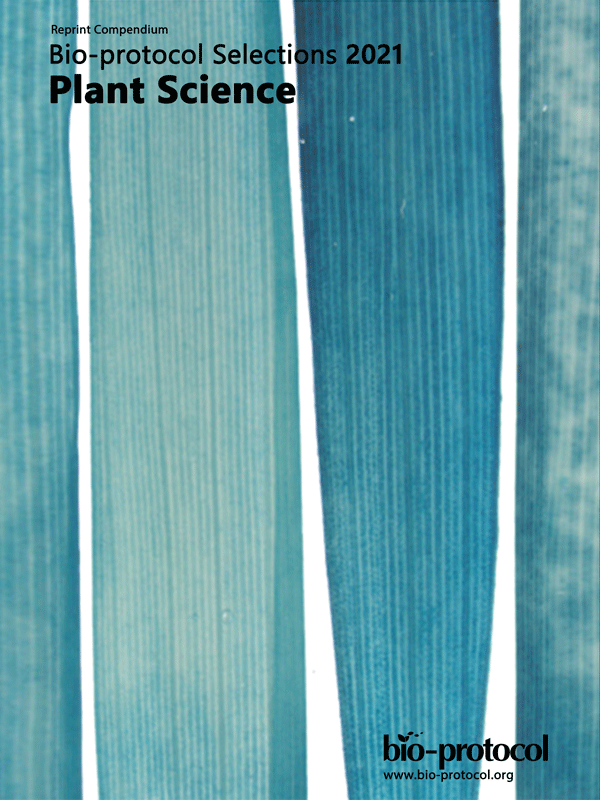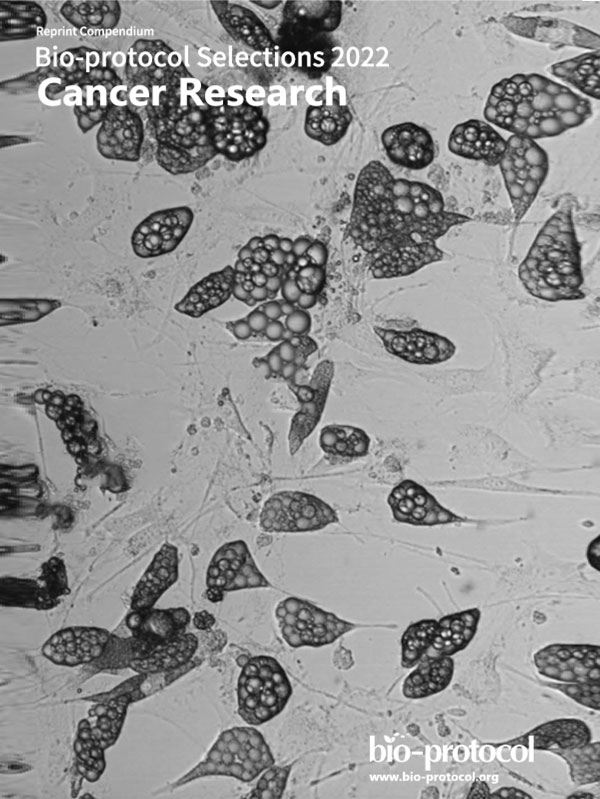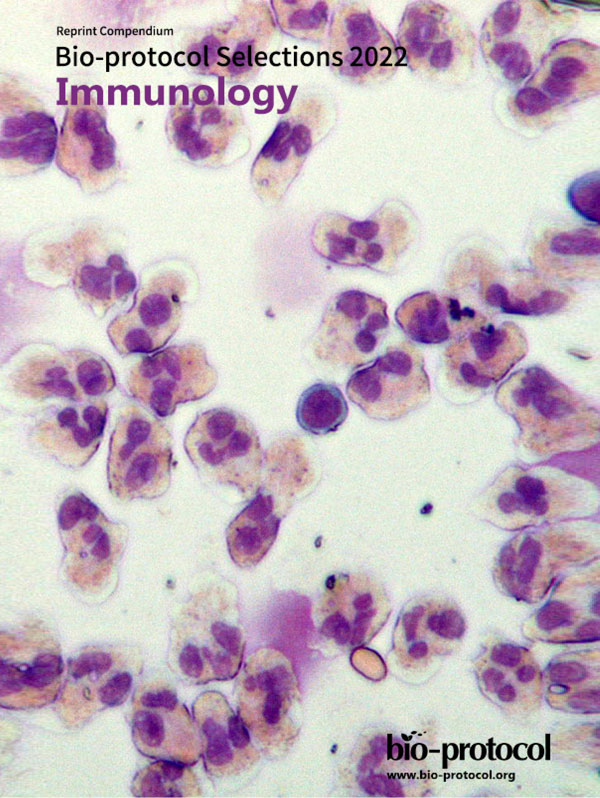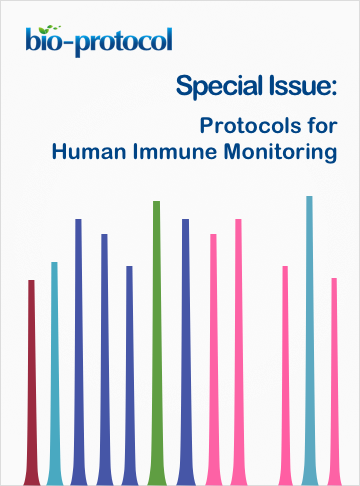- Submit a Protocol
- Receive Our Alerts
- EN
- EN - English
- CN - 中文
- Protocols
- Articles and Issues
- For Authors
- About
- Become a Reviewer
- EN - English
- CN - 中文
- Home
- Protocols
- Articles and Issues
- For Authors
- About
- Become a Reviewer
Induction of Connexin-hemichannel Opening
Published: Vol 4, Iss 17, Sep 5, 2014 DOI: 10.21769/BioProtoc.1220 Views: 8231
Reviewed by: Vanesa Olivares-IllanaAnonymous reviewer(s)

Protocol Collections
Comprehensive collections of detailed, peer-reviewed protocols focusing on specific topics
Related protocols
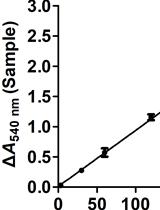
In vitro Nitrate Reductase Activity Assay of Mycolicibacterium smegmatis Crude Extract
Wei Tan [...] Guo-Ping Zhao
Jul 20, 2021 2098 Views
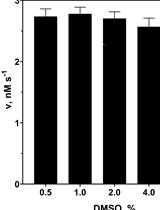
Assay for Protealysin-like Protease Inhibitor Activity
Igor M. Berdyshev [...] Ilya V. Demidyuk
Oct 5, 2022 701 Views
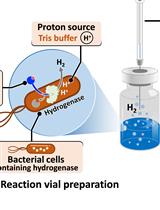
H2 Production from Methyl Viologen–Dependent Hydrogenase Activity Monitored by Gas Chromatography
Nuttavut Kosem
Dec 5, 2023 130 Views
Abstract
Connexins (Cxs) are integral membrane proteins of vertebrates that associate to form hexameric transmembrane channels, named hemichannels. Twenty-one Cx types have been described, which are named according to their molecular weight. Cxs are expressed in many cell types, e.g. epithelial cells, astrocytes and immune cells. Hemichannels allow the passage of molecules of up to 1-2 kDa along the concentration gradient. When surface-exposed, hemichannels mediate the exchange of molecules between the cytosol and the extracellular space. Hemichannels are closed by default, but several cues inducing their opening have been described, e.g. a drop in the extracellular Ca2+ concentration (Evans et al., 2006) or infection with enteric pathogens (Puhar et al., 2013; Tran Van Nhieu et al., 2003). This protocol was used with epithelial cells, in particular with polarized and non-polarized intestinal epithelial TC7 cells and with Hela cells that were stably transfected with Cx26 or Cx43 (Paemeleire et al., 2000). Nevertheless, it could likely be used with other Cx-expressing cell types. Whether hemichannels are open can be determined by electrophysiology or by measuring the release into the extracellular medium of a hemichannel permeable molecule (for example, ATP) or the uptake of a hemichannel-permeable, plasma membrane-impermeant molecule [for example, the fluorescent dye ethidium bromide-see associated protocol “Dye-uptake Experiment through Connexin Hemichannels” (Puhar and Sansonetti, 2014)].
Keywords: HemichannelBackground
Materials and Reagents
- Cell line of interest and assorted cell culture media and plasticware for propagation from supplier of choice
- Shigella flexneri (wild-type or mutant of interest) expressing the adhesin AfaE [for example, serotype 5a wild-type strain M90T, serotype 5a non-invasive mxiD- mutant (for negative controls), or serotype 5a ipgD- mutant (upon infection with this strain hemichannels will stay open for extended time)]
- Salmonella enterica serovar Typhimurium (for example wild-type strain SL1344)
- Enteropathogenic Escherichia coli (EPEC) (for example serotype O127: H6 wild-type strain E2348/69)
- Biocoat intestinal epithelium differentiation environment (BD Biosciences, catalog number depends on well size)
- DMEM low glucose (Life Technologies, Gibco®, catalog number: A1515401 )
- 100x MEM non-essential amino acids (Life Technologies, Gibco®, catalog number: 11140050 )
- 100x 10,000 U/ml penicillin-streptomycin (Life Technologies, Gibco®, catalog number: 15140122 )
- Fetal bovine serum (FBS) (heat-inactivated) (Life Technologies, Gibco®, catalog number: 10500056 )
- Hank’s buffered salt solution (HBSS) (no phenol red) (Life Technologies, Gibco®, catalog number: 14025092 )
- Hank’s buffered salt solution (HBSS) (no calcium, no magnesium, no phenol red) (Life Technologies, Gibco®, catalog number: 14175095 )
- 10x HBSS stock solutions instead of ready to use HBSS if desired (Life Technologies, Gibco®, catalog numbers: 14065056 and 14185052 )
- 1 M HEPES (Life Technologies, Gibco®, catalog number: 15630080 )
- 1 M MgCl2
- 0.5 M Na-EGTA
- Growth media for bacteria [for example Luria-Bertani broth (Life Technologies, catalog number: 10855001 ); Luria-Bertani agar powder prepared according to manufacturer’s instructions (Life Technologies, catalog number: 22700025 ) for Salmonella and EPEC; tryptic soy broth (soybean-casein digest medium, BD, catalog number: 257107 ); tryptic soy agar powder prepared according to manufacturer’s instructions (soybean-casein digest agar medium, Difco, catalog number: 236950 ) for Shigella]
- Growth media for bacteria containing Congo red (see Recipes)
- Culture medium for propagation of TC7 cells (see Recipes)
- Culture medium for propagation of HelaCx26 or HelaCx43 cells (see Recipes)
- HBSS solution (see Recipes)
- HBSS solution devoid of Ca2+ (see Recipes)
Equipment
- Incubator for cell culture
- Cover slips of desired size (e.g. 24 well plates) (if desired)
- Water bath
- Pipettes
- Aspiration
- Clean bench
- Incubator for bacterial cultures
- Centrifuge adapted to spin culture plates (for infections with EPEC)
Procedure
- Cells were kept in matching medium at 37 °C and 10% CO2 in a humid environment (incubator) and passaged according to standard protocols.
- Cells were seeded in culture plates or on cover slips of desired size (e.g. 24 well plates) the day before the experiment and used at 70-80% confluency. For infections, cells were kept in medium devoid of antibiotics for at least 24 h.
- To obtain polarized TC7 cells the Biocoat Intestinal Epithelium Differentiation Environment was used according to the protocol provided by the producer.
To induce hemichannel opening with low extracellular Ca2+- Cells were carefully washed twice with warm (37 °C) HBSS and once with warm HBSS devoid of Ca2+. For polarized TC7 cells both the apical and the basolateral sides have to be washed with buffer (by carefully lifting the transwell chambers containing the cells with tweezers and substituting the buffer in the well). For negative controls, only HBSS was used.
- Fresh warm HBSS devoid of Ca2+ was added and cells were incubated at 37 °C (e.g. in an incubator, a heated microscope or floating in a water bath). For polarized TC7 cells both the apical and the basolateral sides have exposed to HBSS devoid of Ca2+. For negative controls, HBSS was used.
- Hemichannels can be closed again by exchanging HBSS devoid of Ca2+ with HBSS.
To induce hemichannel opening with Shigella- Cells were carefully washed twice with HBSS at RT just before infection. Cells are washed and kept at RT (rather than using warm buffer) to synchronize infection. Indeed, the activity of the type III secretion system (T3SS-the main virulence determinant in Shigella, Salmonella and EPEC) is temperature-dependent, for example in Shigella the T3SS is not active below 35 °C. Therefore, samples are shifted to 37 °C to trigger infection only after bacterial adhesion to the cell surface.
Bacterial strains were conserved as glycerol stocks at -80 °C. Shigella was streaked out on soybean-casein digest agar containing 0.01% (w/v) Congo red and grown over-night at 37 °C to select virulent colonies (virulent colonies are red, colonies that have lost the virulence plasmid are whitish). A single colony was picked, grown over-night at 37 °C and 200 rpm in soybean-casein digest broth, with antibiotics if indicated, and a 200-fold dilution sub-cultured to OD600 nm = 0.3-0.5.
- Bacteria were diluted in HBSS at RT, added to non-polarized cells at RT at a multiplicity of infection (MOI) of 1: 5 (target cell: bacteria) and allowed to attach for 15 min. For polarized TC7 cells, bacteria were added on the apical side at an MOI of 1: 40.
- HBSS was removed to eliminate non-adhered bacteria (in polarized cells the buffer has to be exchanged both on the apical and basolateral side to control the temperature), warm (37 °C) HBSS was added and cells were incubated at 37 °C (e.g. in an incubator or floating in a water bath) for the desired time (e.g. 15 min).
To induce hemichannel opening with Salmonella- Cells were carefully washed twice with HBSS at RT just before infection.
Bacterial strains were conserved as glycerol stocks at -80 °C. Salmonella was streaked out on Luria-Bertani (LB)-agar to isolate colonies and grown overnight at 37 °C. The next evening a single colony was picked, grown overnight at 37 °C and 200 rpm in LB-broth, with antibiotics if indicated.
- Bacteria were diluted in HBSS at RT and added at RT (on the apical side for polarized TC7 cells) at a multiplicity of infection (MOI) of 1: 2.5 (target cell: bacteria).
- Cells were incubated at 37 °C (e.g. in an incubator or floating in a water bath) for the desired time (e.g. 2 min-infections with Salmonella proceed very quickly to bacterial adhesins).
To induce hemichannel opening with EPEC- Cells were carefully washed twice with HBSS at RT just before infection.
Bacterial strains were conserved as glycerol stocks at -80 °C. EPEC was streaked out on Luria-Bertani (LB)-agar to isolate colonies and grown overnight at 37 °C. The next evening a single colony was picked, grown overnight at 37 °C and 200 rpm in LB-broth, with antibiotics if indicated.
- Bacteria were grown over night, diluted in HBSS at RT and added at RT (on the apical side for polarized TC7 cells) at a multiplicity of infection (MOI) of 1: 2.5 (target cell: bacteria).
- Bacteria were centrifuged onto cells at 180 x g for 10 min at RT by spinning the culture plate in an appropriate centrifuge to promote their adhesion.
- HBSS was removed to eliminate non-adhered bacteria (in polarized cells the buffer has to be exchanged both on the apical and basolateral side to control the temperature), warm (37 °C) HBSS was added and cells were incubated at 37 °C (e.g. in an incubator or floating in a water bath) for the desired time (e.g. 2 h-infections with EPEC proceed very slowly.
- Cells were carefully washed twice with warm (37 °C) HBSS and once with warm HBSS devoid of Ca2+. For polarized TC7 cells both the apical and the basolateral sides have to be washed with buffer (by carefully lifting the transwell chambers containing the cells with tweezers and substituting the buffer in the well). For negative controls, only HBSS was used.
Representative data
- Notes about reproducibility and variability in results.
- If hemichannel opening is induced by lowering the extracellular Ca2+ concentration, variability is lower (10-20%) than when induced by infection (20-30%). It is best to prepare triplicates of quadruplicates for infections (ideally from separate cultures to avoid dilution-dependent artifacts).
- If hemichannels do not open upon exposure to medium devoid of Ca2+, residual Ca2+ might be present (e.g. because the washing steps were not performed carefully).
- If hemichannel opening is induced by lowering the extracellular Ca2+ concentration, variability is lower (10-20%) than when induced by infection (20-30%). It is best to prepare triplicates of quadruplicates for infections (ideally from separate cultures to avoid dilution-dependent artifacts).
Notes
- Many cell lines have lost expression of Cxs and therefore do not have hemichannels. Make sure your cell line of interest does.
- During the experiment, handle cells carefully, as hemichannels are mechanosensitive. Excessive shaking and vigorous exchange of media will induce hemichannel opening and therefore increase the background for subsequent measurements.
- For HBSS, 10x stock solutions may be used.
- For infections, HBSS may be substituted with DMEM devoid of phenol red for washes and incubations with bacteria.
- If you wish to quantify molecules that are released when hemichannels open, use sufficient (cells should be well covered, e.g. 200 µl in a 24-well plate), but not high volumes of buffer during incubations, or else the molecules of interest will be unnecessarily diluted.
- Shigella, Salmonella and EPEC differ in their capacity to adhere to epithelial cells and the speed at which adhesion and infection take place. Therefore, the steps in which bacteria are added and the incubation times have to be adapted.
Recipes
- Culture medium containing Congo red
Prepare a 1% (weight/volume) concentrated stock solution of Congo red (100x), for example 0.5 g Congo red powder in 50 ml distilled water. Sterilize by filtration using filters with 0.2 µm pore size and sufficient filtration capacity for the volume you prepare. Add Congo red stock solution to liquid Soybean-Casein Digest Agar, for example, after autoclaving the dissolved powder, when it has cooled to about 55 °C. Add Congo red to a final concentration of 0.01% (weight/volume), for example 5 ml Congo red stock solution in 500 ml growth medium.
- Culture medium for propagation of TC7 cells
Mix 500 ml sterile DMEM with 5 ml sterile penicillin + streptomycin (100 U/ml penicillin and 100 µg/ml streptomycin final, optional), 5 ml sterile non-essential amino acids (from 100x stock solution) and 50 ml sterile FBS.
Stored at 4 °C
- Culture medium for propagation of HelaCx26 or HelaCx43 cells
Mix 500 ml sterile DMEM with sterile 5 ml penicillin + streptomycin (100 U/ml penicillin and 100 µg/ml streptomycin final, optional) and sterile 50 ml FBS
Stored at 4 °C
- HBSS solution
Mix HBSS with 1M HEPES to final concentration of 20 mM (e.g. 1 ml 1 M HEPES for 50 ml final volume)
- HBSS solution devoid of Ca2+
Mix HBSS devoid of calcium and magnesium with 1M HEPES to final concentration of 20 mM (e.g. 1 ml 1 M HEPES for 50 ml final volume), MgCl2 to final concentration of 1 mM (e.g. 50 µl from 1 M stock) and EGTA to final concentration of 0.1 mM (e.g. 10 µl from 0.5 M stock).
Acknowledgments
A.P. was a recipient of subsequent EMBO Long-Term and Marie Curie Intra-European Fellowships. This project was supported by ANR grant 2010 MIDI 007 01 to A.P. and P.J.S. and ERC Advanced Grant HOMEOEPITH to P.J.S. A first short version of this protocol was published in Puhar et al. (2013).
References
- Evans, W. H., De Vuyst, E. and Leybaert, L. (2006). The gap junction cellular internet: connexin hemichannels enter the signalling limelight. Biochem J 397(1): 1-14.
- Paemeleire, K., Martin, P. E., Coleman, S. L., Fogarty, K. E., Carrington, W. A., Leybaert, L., Tuft, R. A., Evans, W. H. and Sanderson, M. J. (2000). Intercellular calcium waves in HeLa cells expressing GFP-labeled connexin 43, 32, or 26. Mol Biol Cell 11(5): 1815-1827.
- Puhar, A. and Sansonetti, P. J. (2014). Dye-uptake Experiment through Connexin Hemichannels. Bio-protocol 4(17): e1221.
- Puhar, A., Tronchère, H., Payrastre, B., Tran Van Nhieu, G. and Sansonetti, P. J. (2013). A Shigella effector dampens inflammation by regulating epithelial release of danger signal ATP through production of the lipid mediator PtdIns5P. Immunity 39(6): 1121-1131.
- Tran Van Nhieu, G., Clair, C., Bruzzone, R., Mesnil, M., Sansonetti, P. and Combettes, L. (2003). Connexin-dependent inter-cellular communication increases invasion and dissemination of Shigella in epithelial cells. Nat Cell Biol 5(8): 720-726.
Article Information
Copyright
© 2014 The Authors; exclusive licensee Bio-protocol LLC.
How to cite
Puhar, A. and Sansonetti, P. J. (2014). Induction of Connexin-hemichannel Opening. Bio-protocol 4(17): e1220. DOI: 10.21769/BioProtoc.1220.
Category
Microbiology > Microbe-host interactions > In vitro model > Cell line
Microbiology > Microbial biochemistry > Protein > Activity
Cell Biology > Cell-based analysis > Transport
Do you have any questions about this protocol?
Post your question to gather feedback from the community. We will also invite the authors of this article to respond.
Tips for asking effective questions
+ Description
Write a detailed description. Include all information that will help others answer your question including experimental processes, conditions, and relevant images.
Share
Bluesky
X
Copy link





